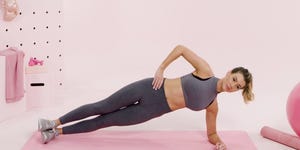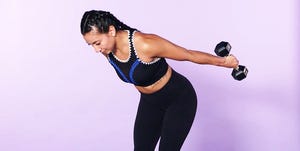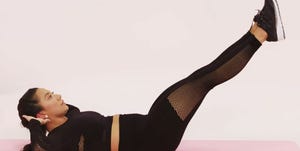This Single Move Targets Your Butt, Legs, AND Core
Reasons to get flustered at how surprisingly difficult a task turns out to be: Helping your kid with basic algebra; playing that peg board game at Cracker Barrel; and attempting a basic single-leg deadlift without weights.
After all, all you’re doing is hinging at the hips—minus the added resistance from a dumbbell, no less. But the balance and stability required in this basic move will eat up your glutes, your nervous system, and your ego. So obviously, you have to try it ASAP.
How To Do A Single-Leg Deadlift
How to: Stand with both feet under hips. Shift your weight to the right leg, which should be nice and straight with a soft bend in the knee. Begin to drive your left foot back like you’re stamping the bottom of your foot on the wall behind you, keeping your leg straight. Simultaneously, slowly start hinging at the waist, tipping your torso forward until it’s almost parallel to the floor. Keep your arms straight, at shoulder height, and perpendicular to the floor at all times. At the bottom of the position, your body should be in a straight line from the top of your head to the bottom of your left foot. Then, begin pulling your left leg forward while keeping it straight, and lift your torso up until you’re standing again. That’s one rep. Repeat all reps on one side, then switch legs.
Reps/sets for best results: Single-leg deadlifts are super versatile depending on your goal and skill level. If you’re just starting out, begin with three sets of 10 reps, no weight, with 90 seconds of rest in between.
Single-leg deadlifts work the hamstrings, gluteus maximus, gluteus medius, ankles, and the core.
Once you start to feel comfortable with the balance component, you can work toward goals: If your goal is muscular endurance, hit three sets of 15 to 20 reps with just 60 seconds rest in between. If you’re aiming for strength, add some weights (dumbbells or barbell) and shoot for three sets of five to six reps, with three minutes of rest in between. If you’re looking to increase muscle size, add weight, and do three sets of 8 to 12 reps with 90 to 120 seconds rest in between.
Form tips: Be sure to keep your body in a straight line at the bottom of the move. “When your body is parallel to the floor and leg is extended behind you, the hip has a tendency to roll up toward the ceiling—you want to prevent it from rotating at all,” says Matt Pippin, CSCS, strength and mobility coach at Pippin Performance in San Diego. Try this cue: Imagine you have a glass of water (or wine!) resting on your low back when you hit the bottom of the move—don’t let it spill.
Even with no equipment, this move is a burner, Pippin says. But as you progress, you can add dumbbells or kettlebells to each hand.
Benefits Of Single-Leg Deadlifts
Single-leg deadlifts work all the major muscles it’s two-legged namesake does: the hamstrings, gluteus maximus, gluteus medius, ankles, and the core. But while it challenges the same muscles, if you use lighter weights (or none at all), it puts way less stress on the spine, says Pippin.
Plus, one leg adds a balance and stability challenge, so there’s an increase in the glute demand (read: better booty builder). And that higher demand is the real selling point of this burner: “If you want to be able to do things like run, walk, and jump, you need a strong posterior chain—aka, all the muscles of the back side of the body,” Pippin explains.
Want a complete butt routine? Try this full workout:
Make Single-Leg Deadlifts Part Of Your Workout
Work this move into your routine two to three times per week (on the higher end for building strength, the lower for overall wellness).
The balance and stability will work your nervous system, so it’s good to get after it at the beginning of your routine when you’re still fresh, Pippin says. However, as long as you’re not adding any weight, you can definitely incorporate this move as a finisher to “empty the gas tank,” or as part of a HIIT routine to keep your heart rate elevated.



This move pairs well with any other single-leg-dominant exercise, like lunges, single-leg hip thrusts, or lateral lunges. For a total-body day, try single-leg deadlifts with unilateral upper body exercises (i.e., single-arm press, single-arm rows).
And remember, this move is not as easy as it appears. One way to make it easier: Stand near a wall, chair, or something close to help with balance. “You can get comfortable with the movement pattern first,” Pippin says, “Then remove the object and master the balancing component.” Whatever variety you choose, get ready to feel the booty burn.
Source: Read Full Article


